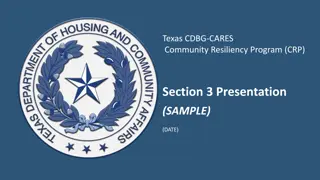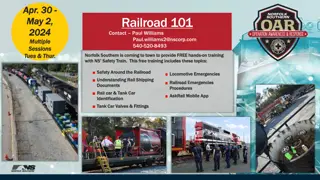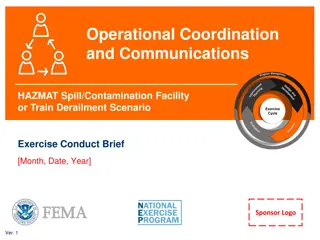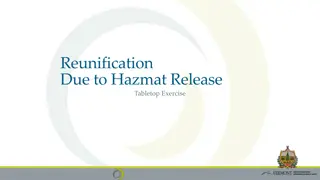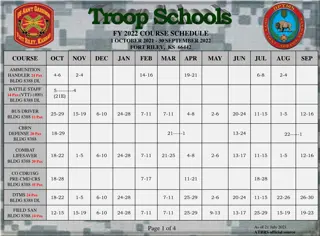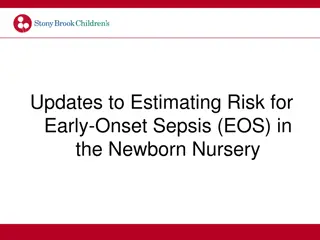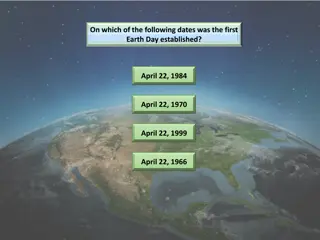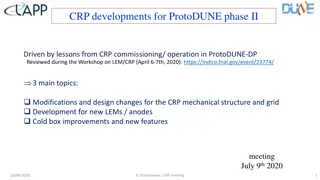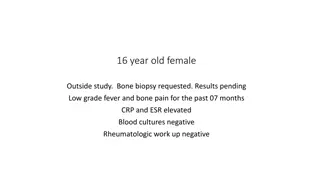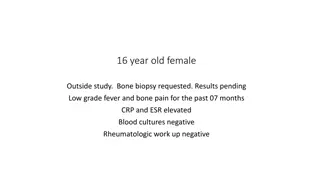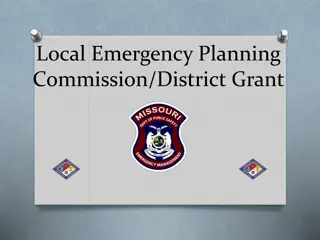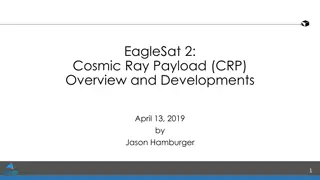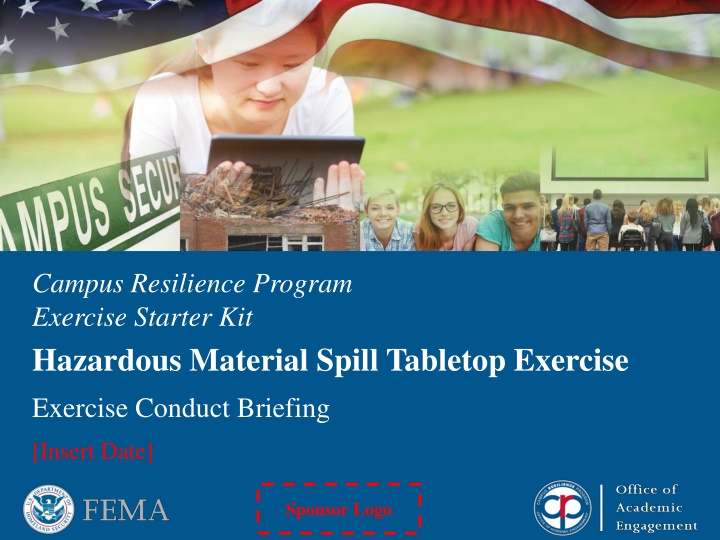
Campus Resilience Program Exercise Starter Kit Briefing
This briefing provides a baseline document for higher education institutions to evaluate their emergency plans and procedures. It includes sample content that can be customized, along with guidelines for incorporating the sponsoring organization's logo. The briefing is designed for use in conjunction with the Tornado Situation Manual and Facilitator Guide. It covers elements such as welcome and introductions, administrative remarks, exercise schedule, and an overview of the hazardous material spill tabletop exercise to enhance campus resilience.
Download Presentation

Please find below an Image/Link to download the presentation.
The content on the website is provided AS IS for your information and personal use only. It may not be sold, licensed, or shared on other websites without obtaining consent from the author. If you encounter any issues during the download, it is possible that the publisher has removed the file from their server.
You are allowed to download the files provided on this website for personal or commercial use, subject to the condition that they are used lawfully. All files are the property of their respective owners.
The content on the website is provided AS IS for your information and personal use only. It may not be sold, licensed, or shared on other websites without obtaining consent from the author.
E N D
Presentation Transcript
Campus Resilience Program Exercise Starter Kit Hazardous Material Spill Tabletop Exercise Exercise Conduct Briefing [Insert Date] Sponsor Logo Sponsor Logo
READ FIRST The purpose of this Exercise Conduct Briefing is to provide a baseline exercise document that institutions of higher education can use to assess their emergency plans, policies, and procedures The sample content contained in this document can be tailored as necessary by filling in all [bracketed content that is highlighted in red] To insert the sponsoring organization s logo, navigate to the View menu and select Slide Master This briefing is to be used in tandem with the Tornado Situation Manual and Facilitator Guide so any changes made to this briefing will need to be aligned with those documents **Delete slide prior to conduct**
Welcome and Introductions [Name] [Title] [Department/Agency/Organization] [Name] [Title] [Department/Agency/Organization] Sponsor Logo 3
Administrative Remarks Cell phone etiquette Evacuation procedures Restroom locations Sponsor Logo 4
Exercise Schedule Activity [Welcome and Introductions] [Exercise Overview] Module 1: Initial Response Break Module 2: Continued Recovery Break Module 3: Short-Term Recovery [Exercise Hot Wash] [Closing Remarks] Time [00:00 a.m.] [00:00 a.m.] [00:00 a.m.] [00:00 a.m.] [00:00 p.m.] [00:00 p.m.] [00:00 p.m.] [00:00 p.m.] [00:00 p.m.] Sponsor Logo 5
Exercise Overview Sponsor Logo 6
Exercise Overview Background: This Tabletop Exercise (TTX) is made available through the Campus Resilience (CR) Program Exercise Starter Kits Each Exercise Starter Kit aims to support practitioners and senior leaders from the academic community in assessing emergency plans, policies, and procedures while also enhancing overall campus resilience Purpose: This specific Exercise Starter Kit will provide the opportunity to examine response and recovery operations related to a hazardous material (HazMat) spill incident near campus Sponsor Logo 7
Exercise Overview (cont.) Scope: This [insert duration]-TTX is divided into three Modules: Module 1 will examine initial response operations in the aftermath of a train derailment and subsequent HazMat incident Module 2 will examine continued response operations in the aftermath of a HazMat incident Module 3 will examine short-term recovery operations following a HazMat incident Each Module will consist of two activities: 1. Scenario Overview: Each Module will contain a detailed overview of the scenario 2. Facilitated Discussions: Participants will engage in facilitated discussions surrounding a set of discussion questions Sponsor Logo 8
READ FIRST The exercise objectives contained in the following slide(s) are provided as sample objectives These can be tailored as appropriate to align with the overarching goals and desired outcomes for the exercise Please note that changes made to these objectives will need to be reflected in the associated Facilitator Guide and Situation Manual for this scenario **Delete slide prior to conduct**
Exercise Objectives 1. Operational Coordination: Assess the ability to establish an effective command structure that integrates all critical stakeholders to ensure campus and community resources are used efficiently to respond to and recover from a hazardous material incident Mass Care Services: Examine the ability to provide life-sustaining and human services to affected populations at your institution to include hydration, feeding, sheltering, temporary housing, evacuee support, and distribution of emergency supplies in the aftermath of a hazardous material incident Public Health, Healthcare, and Emergency Medical Services: Assess the ability to coordinate with emergency services personnel to provide lifesaving medical treatment and targeted public health, medical, and behavioral health support to all affected populations on and around campus following a hazardous material incident Public Information and Warning: Assess the ability to deliver coordinated, actionable, and timely information to critical partners and stakeholders when faced with a hazardous material incident 2. 3. 4. Sponsor Logo 10
Participant Roles and Responsibilities Facilitator: Provides situation updates and facilitates discussions Players: Respond to the situation presented based on current plans, policies, and procedures Observers: Visit or view selected segments of the exercise without directly engaging in exercise discussions Support Staff: Performs administrative and logistical support during the exercise (e.g., registration) [Insert additional participant roles as appropriate] Sponsor Logo 11
Participating Organizations [Insert Participating Organization] [Insert Participating Sub-Organization] [Insert Participating Organization] [Insert Participating Sub-Organization] [Insert Participating Organization] [Insert Participating Sub-Organization] Sponsor Logo 12
Exercise Guidelines This exercise is being conducted in an open, low-stress, no-fault environment; varying viewpoints, even disagreements, are expected Act in real-world roles for your institution or organization when considering the scenario Decisions are not precedent-setting; this is an open discussion The focus should be on identifying suggestions and recommended actions for improving preparedness, response, and recovery efforts [Insert any additional guidelines that may be relevant to the exercise] Sponsor Logo 13
Assumptions and Artificialities The exercise scenario is plausible and events occur as they are presented Players will use existing plans, policies, procedures, and resources to guide responses There is no hidden agenda nor are there any trick questions The scenario assumes certain player actions as it moves through each phase; players should first discuss the actions stipulated by the scenario Players are welcome to engage in what if discussions of alternative scenario conditions [Insert any additional assumptions or artificialities that may be relevant to the exercise] Sponsor Logo 14
Start of Exercise Sponsor Logo 15
Module 1: Initial Response Sponsor Logo 16
Module 1: Scenario Overview [Insert Date and Time] It is the end of the spring semester and many students faculty, and staff members are spending time outside Consequently, a large percentage of the campus community is outside when a major train collision occurs in the area, causing a tanker car carrying dangerous chemicals to rupture Figure #1: Train Tracks A gas cloud begins to move throughout the area surrounding your institution Sponsor Logo 17
Module 1: Scenario Overview (cont.) [Insert Date and Time] Local 9-1-1 call centers receive a swarm of calls from panicked individuals regarding the gas cloud Your institution begins to receive calls from concerned students, faculty, and staff in the area Your health center begins to receive multiple complaints from individuals reporting headaches, dizziness, uncontrollable coughing, and difficulty breathing [Insert Date and Time] The local fire department alerts your campus of an ongoing HazMat incident where a train transporting industrial chemicals derailed, releasing an unknown toxic gas into the surrounding environment By this time, images and videos of the incident rapidly circulate throughout social media Sponsor Logo 18
Module 1: Discussion Questions (1/4) Operational Coordination 1. How does your institution maintain awareness of hazardous materials that travel near or are stored on your campus? 2. What plans, policies, and procedures does your institution have in place to guide response efforts during a potential HazMat incident? 3. How would your institution establish a command structure to coordinate your response efforts? 4. What resource gaps could limit your institution s ability to ensure the safety and security of students, faculty, and staff during a HazMat incident? 5. [Insert additional discussion questions as appropriate] Sponsor Logo 19
Module 1: Discussion Questions (2/4) Mass Care Services 1. What plans, policies, and procedures does your institution have in place to mitigate the disruption of essential campus services? 2. What are your institution s evacuation/shelter-in-place plans, procedures, and protocols? 3. What resource gaps could limit your institution s ability to provide mass care services? 4. [Insert additional discussion questions as appropriate] Sponsor Logo 20
Module 1: Discussion Questions (3/4) Public Health, Healthcare, and Emergency Medical Services 1. What plans, policies, and procedures does your institution have in place to guide your actions during a campus medical crisis? 2. At this point in the scenario, what would be your health and medical priorities? 3. What other immediate actions would your institution take in order to identify and treat on-campus victims of potential chemical exposure? 4. How does your institution encourage students, faculty, and staff to take individual steps to mitigate the potential impacts of a HazMat incident? 5. [Insert additional discussion questions as appropriate] Sponsor Logo 21
Module 1: Discussion Questions (4/4) Public Information and Warning 1. How does your institution ensure consistent and coordinated public messaging throughout the initial response period? 2. How and when does your institution issue warnings, alerts, and other emergency messaging? 3. What individual, office, or department coordinates and delivers your institution s public messaging? 4. How will your institution use social media platforms in support of incident communications and public messaging? 5. [Insert additional discussion questions as appropriate] Sponsor Logo 22
Break Sponsor Logo 23
Module 2: Continued Response Sponsor Logo 24
Module 2: Scenario Overview [Insert Date and Time] Students, faculty, and staff begin to self-evacuate the area and your institution is inundated with calls from worried parents asking how your institution is responding to the event The number of patients exhibiting or claiming to exhibit symptoms continues to rise with [insert number] complaints and [insert number] hospitalizations Figure #2: Decontamination Procedures Videos of the situation continue to circulate on social media, oftentimes citing incorrect or misleading information Several post report a large yellow-green mushroom cloud Sponsor Logo 25
Module 2: Scenario Overview (cont.) [Insert Date and Time] First responders confirm that the train was transporting chlorine Due to shifting wind conditions, additional concerns are raised regarding impacted areas around the region After extinguishing the fire, first responders begin containment and clean-up operations, but specialists estimate it may take several hours before there is measurable improvement to air quality Your institution s health center is overwhelmed with students reporting various symptoms and calls from concerned students, faculty, and staff continue to flow in with questions about what they should be doing to protect themselves Sponsor Logo 26
Module 2: Discussion Questions (1/4) Operational Coordination 1. How have your institution s priorities changed as more information about the HazMat incident has become available? 2. How would your institution maintain an effective command structure to coordinate emergency response efforts? 3. What resources are currently available? 4. Who are the key external stakeholders that would support response efforts? 5. [Insert additional discussion questions as appropriate] Sponsor Logo 27
Module 2: Discussion Questions (2/4) Mass Care Services 1. How have your mass care priorities changed as the HazMat incident unfolds? How would your institution track hospitalizations, fatalities, and self- evacuations? How will your institution account for students, faculty, staff, and campus visitors in affected areas? What emergency housing plans, policies, and procedures does your institution have in place? In addition to housing, what other services will your institution need to provide for the duration of this incident? [Insert additional discussion questions as appropriate] 2. 3. 4. 5. 6. Sponsor Logo 28
Module 2: Discussion Questions (3/4) Public Health, Healthcare, and Emergency Medical Services 1. What unique considerations are there to inform medical response efforts (e.g., the type of hazardous material involved, geographic impacts on chemical dispersal, etc.)? 2. At this point in the scenario, what are your health and medical priorities? 3. What resource gaps could hinder your ability to provide emergency healthcare and medical services? 4. How would your institution coordinate with emergency responders to implement decontamination procedures (e.g., removal and disposal of contaminated clothing, appropriate bathing measures, etc.)? 5. How will you coordinate with emergency responders and emergency care facilities to identify, locate, and transport sick individuals? 6. [Insert additional discussion questions as appropriate] Sponsor Logo 29
Module 2: Discussion Questions (4/4) Public Information and Warning 1. How does your institution ensure consistent and coordinated public messaging throughout this phase of response operations? How does your institution ensure timely and accurate situational updates for internal stakeholders throughout the response period? How do your messaging priorities change as you receive more information concerning the HazMat incident? How does your institution notify families, key stakeholders, and the public of students who have been sick or hospitalized due to the HazMat spill? How does your institution counteract false or misleading information? [Insert additional discussion questions as appropriate] 2. 3. 4. 5. 6. Sponsor Logo 30
Module 3: Short-Term Recovery Sponsor Logo 31
Module 3: Scenario Overview [Insert Date and Time] Estimates indicated that full clean-up may now last up to 5 days In total, [insert number] students, faculty, and staff have reported symptoms of chemical exposure, [insert number] have been hospitalized, [insert number] are in critical condition, and [insert number] have died as a result of their injuries Figure #3: Media Personnel Conducting Interviews Some hospitalized students begin speaking with the media regarding the incident Your institution continues to receive a number of calls asking for information and interviews Sponsor Logo 32
Module 3: Scenario Overview (cont.) [Insert Date and Time] Emergency response personnel clear the incident site, but there are still some concerns about air quality and safety Many students, parents, faculty, and staff members have expressed fears over returning to campus; some have noted that they refuse to return altogether Some staff members have requested temporary work accommodations Some local businesses have given notice that they will temporarily close as a result of the incident There is major media coverage of the incident and some stories are criticizing your institution s ability to respond to the incident Sponsor Logo 33
Module 2: Discussion Questions (1/4) Operational Coordination 1. How does your institution coordinate the transition from response to short-term recovery efforts? 2. What plans, policies, and procedures guide your institution s recovery process? 3. What resource gaps could limit your institution s ability to meet these priorities? 4. [Insert additional discussion questions as appropriate] Sponsor Logo 34
Module 2: Discussion Questions (2/4) Mass Care Services 1. What plans, policies, and procedures does your institution have in place to return your campus to a healthy and safe environment? 2. How would your institution provide, track, and communicate these services to members of the campus community who may be geographically dispersed? 3. What resource gaps could limit your institution s ability to meet your community s mass care service needs in the aftermath of this type of incident? 4. [Insert additional discussion questions as appropriate] Sponsor Logo 35
Module 2: Discussion Questions (3/4) Public Health, Healthcare, and Emergency Medical Services 1. How would your institution monitor the recovery of students, faculty, and staff? 2. What are your recovery priorities in terms of providing healthcare and medical services? 3. Are there processes in place to handle the medical insurance claims for an incident of this magnitude? 4. What types of information and resources may be available to educate the campus community about the types of impacts to expect from an incident of this type? 5. [Insert additional discussion questions as appropriate] Sponsor Logo 36
Module 2: Discussion Questions (4/4) Public Information and Warning 1. How does your institution ensure consistent, coordinated public messaging throughout the recovery period? How does your institution provide internal stakeholders with timely updates concerning recovery efforts? Who is responsible for monitoring and managing inquiries from affected students, faculty, staff, and alumni? Who is responsible for monitoring and managing inquiries from the media? How does your institution reinforce or restore its reputation in the aftermath of a HazMat incident? How does your institution continue to combat false or misleading information, particularly through social media? [Insert additional discussion questions as appropriate] 2. 3. 4. 5. 6. 7. Sponsor Logo 37
Break Sponsor Logo 38
End of Exercise Sponsor Logo 39
Exercise Hot Wash Sponsor Logo 40
Hot Wash Overview This Hot Wash aims to capture the following information based on observations made throughout the exercise: Overall strengths Overall areas for improvement Major takeaways and action items Sponsor Logo 41
Closing Remarks [Name] [Title] [Department/Agency/Organization] [Name] [Title] [Department/Agency/Organization] Sponsor Logo 42
Adjournment Sponsor Logo 43
Campus Resilience Program Exercise Starter Kit Hazardous Material Spill Tabletop Exercise Exercise Conduct Briefing [Insert Date] Sponsor Logo Sponsor Logo

